#crab pulsar
Text

Púlsar de la Nebulosa del Cangrejo. Imágenes combinadas procedentes del Telescopio Espacial Hubble (en rojo) y del Observatorio de Rayos X Chandra (en azul).
#astronomy#space#pulsar#neutron star#crab nebula#supernova#crab pulsar#hubble#chandra#hubble space telescope#chandra x-ray observatory#astronomía#espacio#nebulosa del cangrejo#púlsar#telescopio espacial hubble#observatorio de rayos-x chandra#estrella de neutrones
9 notes
·
View notes
Text
Y'all, I'm getting emotional.
One of my absolute favorite astronomical bodies is the Crab Nebula, or Messier 1. The Crab Nebula is a "planetary nebula", which means it's the enormous, beautiful corpse of a once-giant star. The star that formed the Crab Nebula went supernova and exploded in 1054, and was so bright at the time of its death that you could see it from Earth during the day - for almost a month. For that month, it was brighter than every single thing in the sky except the moon and the sun. Some of you have probably heard of it, or have at least seen this Hubble picture:

But how many of y'all have zoomed in?
Inside all of those lovely rainbow clouds is the supernova remnant - a neutron star. A neutron star is made of the densest possible material that we know of - any denser, and it'd collapse the rest of the way into a full-fledged black hole. Neutron stars are so unimaginably dense that they're not even made of an element, not really. The star at the center of the Crab Nebula is one, single atomic nucleus 12 miles in diameter, made entirely of close-packed neutrons. One teaspoon would weigh 10 million tons. Imagine taking a passenger jet, condensing it down to the size of a mote of dust, and then filling a spoon with that dust. And it spins too - 30 times a second. That spinning causes huge jets of material to eject from the poles at half the speed of light. The incredibly powerful magnetic field traps any stray particles and accelerates them in circular paths through the nebula. Just LOOK at this shit! See the ghosty shadows of the jets, stretching from the top left corner to the bottom right?

But what's really making me lose it is this Hubble timelapse. The star is making ripples. Its moving. Its been dead for almost a thousand years, but its still putting on its final, spectacular show.
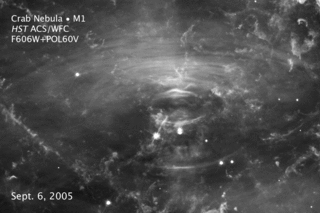
It never ceases to amaze me that the things we call "dead" stars are some of the most dynamic, energetic, and awe-inspiring objects in the universe. Normal stars are downright STAGNANT compared to what these so-called "stellar remnants" get up to. Maybe we shouldn't be thinking of them as dead stars, but as the next phase in a star's life. Just as caterpillars "end" their mundane lives and metamorphose into something new and strange and capable of flight, these stars destroy themselves to leave behind something far more exotic, playing at the edge of the laws of physics in ways we still don't fully understand.
#space#crab nebula#neutron star#supernova#god I fucking love neutron stars#ask me sometime about the first pulsar#hubble#spost#space post
739 notes
·
View notes
Photo

The Spinning Pulsar of the Crab Nebula !
Image Credit: NASA: X-ray: Chandra (CXC), Optical: Hubble (STScI), Infrared: Spitzer (JPL-Caltech)
#art#photography#space#cosmos#cosmic#universe#spinning#pulsar#crab nebula#nebula#nasa#x-ray#chandra#CXC#hubble#spitzer#JPL-Caltech#blast#netron star#supernova
71 notes
·
View notes
Text
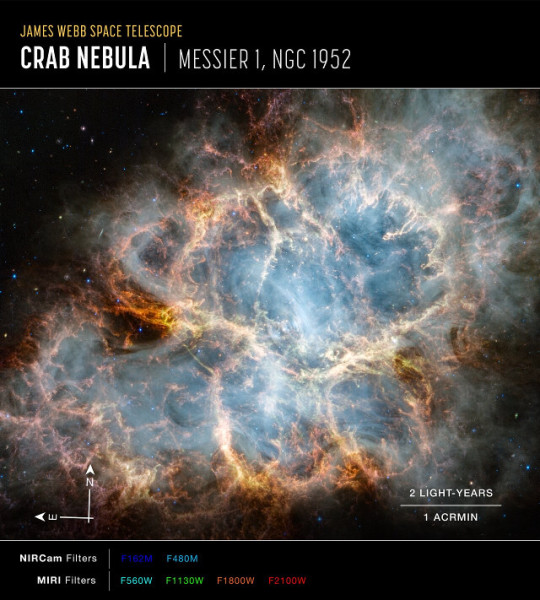
A new image captured by the James Webb Space Telescope depicts the Crab Nebula, the remnants of the supernova spotted on Earth and recorded in 1054, about 6,500 light-years away from Earth. The observation possibilities at the time were limited, to say the least, compared to today's, so there are still questions regarding that supernova. The NIRCam and MIRI instruments allowed to obtain infrared details showing the synchrotron radiation inside it, produced by the pulsar at its center that formed from the core of the progenitor star that exploded in 1054.
0 notes
Text
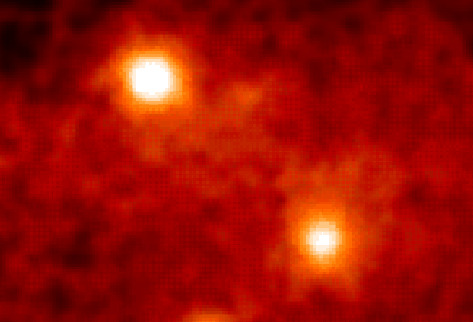
The Crab Nebula and Geminga in Gamma Rays - June 24th, 1995.
“What if you could "see" in gamma-rays? If you could, these two spinning neutron stars or pulsars would be among the brightest objects in the sky. This computer processed image shows the Crab Nebula pulsar (below and right of center) and the Geminga pulsar (above and left of center) in the "light" of gamma-rays. Gamma-ray photons are more than 10,000 times more energetic than visible light photons and are blocked from the Earth's surface by the atmosphere. This image was produced by the high energy gamma-ray telescope "EGRET" onboard NASA's orbiting Compton Observatory satellite.”
#nasa#space#cosmos#universe#astronomy#astrophysics#astrophotography#crab nebula#geminga pulsar#gamma rays
0 notes
Text

the Crab Nebula’s spinning pulsar
1 note
·
View note
Photo

The Spinning Pulsar of the Crab Nebula #NASA https://ift.tt/JRxLgtF
0 notes
Text
"Cosmic" lighthouses, known as pulsars, are rapidly spinning neutron stars that emit X-ray photons in beams that sweep the sky. From far away they appear to pulse! This Hubble visible-light view shows the Crab Nebula pulsar.
433 notes
·
View notes
Photo
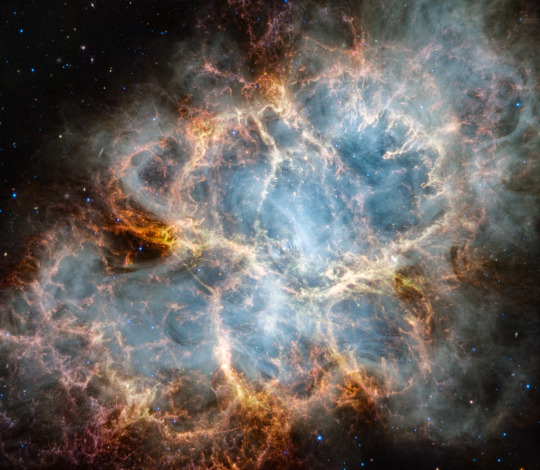
2023 November 9
M1: The Crab Nebula
Image Credit: NASA, ESA, CSA, STScI; Tea Temim (Princeton University)
Explanation: The Crab Nebula is cataloged as M1, the first object on Charles Messier's famous 18th century list of things which are not comets. In fact, the Crab is now known to be a supernova remnant, debris from the death explosion of a massive star witnessed by astronomers in the year 1054. This sharp image from the James Webb Space Telescope’s NIRCam (Near-Infrared Camera) and MIRI (Mid-Infrared Instrument) explores the eerie glow and fragmented strands of the still expanding cloud of interstellar debris in infrared light. One of the most exotic objects known to modern astronomers, the Crab Pulsar, a neutron star spinning 30 times a second, is visible as a bright spot near the nebula's center. Like a cosmic dynamo, this collapsed remnant of the stellar core powers the Crab's emission across the electromagnetic spectrum. Spanning about 12 light-years, the Crab Nebula is a mere 6,500 light-years away in the head-strong constellation Taurus.
∞ Source: apod.nasa.gov/apod/ap231109.html
199 notes
·
View notes
Text

M1 the Crab Nebula. A supernova remnant and pulsar wind nebula 6,500 ly away sitting on the tip top of the left horn of Taurus the Bull. Had difficulty editing this one and not sure if I'm fully happy with it, but it'll do because I'm tired.
109 notes
·
View notes
Photo
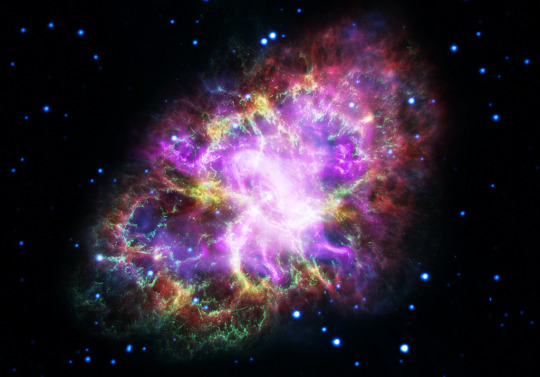
The Multiwavelength Crab : The Crab Nebula is cataloged as M1, the first object on Charles Messier's famous list of things which are not comets. In fact, the Crab is now known to be a supernova remnant, expanding debris from massive star's death explosion, witnessed on planet Earth in 1054 AD. This brave new image offers a 21st century view of the Crab Nebula by presenting image data from across the electromagnetic spectrum as wavelengths of visible light. From space, Chandra (X-ray) XMM-Newton (ultraviolet), Hubble (visible), and Spitzer (infrared), data are in purple, blue, green, and yellow hues. From the ground, Very Large Array radio wavelength data is shown in red. One of the most exotic objects known to modern astronomers, the Crab Pulsar, a neutron star spinning 30 times a second, is the bright spot near picture center. Like a cosmic dynamo, this collapsed remnant of the stellar core powers the Crab's emission across the electromagnetic spectrum. Spanning about 12 light-years, the Crab Nebula is 6,500 light-years away in the constellation Taurus. via NASA
795 notes
·
View notes
Text
The Crab Nebula
August’s Space Object of the Month is the Crab Nebula, the remnant of a supernova observed by Chinese astronomers in the year 1054. Though they didn’t understand what they were seeing at the time, we now know they were witnessing was the death of a star 6,500 light-years from Earth. The supernova was visible during the day for an entire month, and remained visible at night for a further two years before it faded away.


At the centre of the nebula there is a rapidly spinning neutron star, 30 kilometres in diameter, emitting pulses of radiation as it spins on its axis. This pulsar, discovered in 1968 by Jocelyn Bell, ejects twin beams of radiation resulting in the star appearing to pulse at a rate of 30 times per second.
The nebula itself spans six light-years across, and is expanding at a rate of about 1,500 kilometres per second – 0.5% the speed of light.

#space object of the month#space#astronomy#astrophysics#space facts#spaceblr#studyblr#physics studyblr#my studyblr
166 notes
·
View notes
Text
The Crab Nebula is cataloged as M1, the Crab is now known as a supernova remnant, expanding debris from massive star's death explosion, witnessed on planet Earth in 1054 AD.
One of the most exotic objects known to modern astronomers, the Crab Pulsar, a neutron star spinning 30 times a second, is the bright spot near picture center.
Like a cosmic dynamo, this collapsed remnant of the stellar core powers the Crab's emission across the electromagnetic spectrum. Spanning about 12 light-years, the Crab Nebula is 6,500 light-years away in the constellation Taurus 🌟
📷: NASA, ESA, JPL-Caltech, NSF, Chandra X-ray, STScI
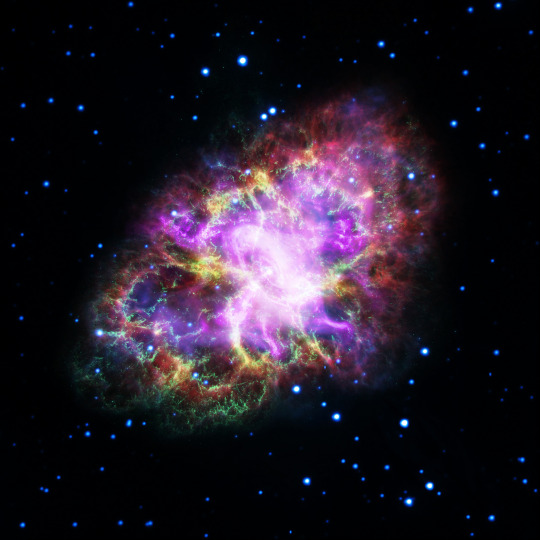
#nasa#astronomy#astrophotography#solar system#astrophysics#hubble#nebula#james webb space technology#physics#james webb images
206 notes
·
View notes
Photo

The Pulsar Powered Crab
Credits: ASU, NASA
44 notes
·
View notes
Text
Greetings, it's me, your favourite purple genius & I have a special dish aka infodump for you:
✨️ Pulsars ✨️
Like I promised to a friend.
I referred to pulsars as 'dead stars', which is not incorrect:
Pulsars are rapidly rotating neutron stars that blast out pulses of radiation at regular intervals ranging from seconds to milliseconds.
The name 'pulsar' can be misleading as these neutron stars don't actually pulse by periodically shrinking & swelling in size. Their pulsing is merely a factor of their orientation in relation to our view of them.
Their light output is mostly consistent.
Pulsars have strong magnetic fields that funnel particles along their magnetic poles, accelerating them to relativistic speeds, which produces two powerful beams of light, one from each pole.
The poles of the magnetic field aren't aligned with the axis of spin of the pulsar: the beams of particles & the light they produce are swept around as the pulsar rotates.
Imagine this as a pair of open scissors spinning on one handle. One blade points upwards (axis of rotation), while the other blade is the beam of light. While the axis of rotation has the same orientation, the direction of the beam turns with the neutron star's spin.
The periodicity of pulsars is caused by these beams of light crossing the line of sight here on Earth, with the pulsar appearing to 'switch off' at points when the light is facing away from us. The time between these pulses is the 'period' of the pulsar.
✨️How do they form?✨️
Just like neutron stars, pulsars are born when stars with masses between four & eight times that of the sun run out of fuel for nuclear fusion.
When the fusion of lighter elements into heavier elements stops - iron is end of the fusion chain - the production of energy that supports the massive star against the inward pressure of its own tremendous gravity also ceases. The star begins to collapse.
The outer layers of the star are blown away in a supernova explosion with only the iron core of the massive star containing masses equivalent to that of the sun up to about 1.5 times that of our star remaining. This crushes down into a width no greater than around 19 to 27 kilometers.
This creates the neuron star: which is composed of 95% neutrons, because the collapse has forced electrons & protons together.
According to NASA, the material that comprises neutron stars is so dense that a mere teaspoon of it would weigh 4 billion tons. This is equivalent to 10,000 Empire State Buildings stacked on a tiny spoon!
This superdense material is prevented from cramming further together as the mass of the stellar core can't overcome the quantum properties of its neutrons.
If the star was massive enough to overwhelm this effect the neutron star would continue to collapse until it transforms into a black hole.
This is the 'Crab pulsar':

Image credit: NASA/CXC/ASU/J.Hester et al.
There you have it! 🌟
✨️What is so intriguing about them?
Pulsars tell about the physics of neutron stars: Under such incredible pressure, matter behaves in ways not seen before in any other environment in the universe. The strange state of matter inside neutron stars is what scientists call 'nuclear pasta': Sometimes, the atoms arrange themselves in flat sheets, like lasagna, or spirals like fusilli, or small nuggets like gnocchi.
They are considered the most reliable & accurate clocks of the universe & can be used for distance measurements!
As mentioned before: detecting gravitational waves!

(Me definitely NOT enjoying this) /s
#donatello infodumps#donnies exceptional mind#turtle net#rottmnt donnie#rottmnt autistic donnie#rise autistic donnie#autistic donatello#space#space is awesome#pulsars#rottmnt donatello#rottmnt#infodumping#infodump#space facts#neutron stars#astrophysics
45 notes
·
View notes
